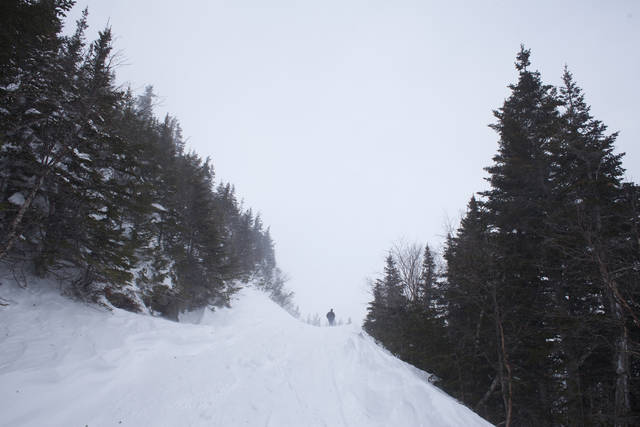Why ski when you can hike?

New York Times / 2018
The White Mountains in New Hampshire is one area where snow hiking and snowshoeing are popular.
Snow hiking is growing in popularity as a wintertime sport globally. Alta Badia ski resort, in Italy’s Dolomites region, saw 50,000 snow hikers in the winter of 2017-18, compared with 30,000 the previous winter, according to the local tourist board. Companies that offer snow hiking excursions also report a rise in business: Discover Banff Tours, which runs snow hiking trips in Banff National Park, had more than 10,000 participants last winter, compared with 6,000 in the winter of 2015-16, said its founder, Jonathan Welsh.
Here’s what you need to know to about snow hiking:
Question: Is there special gear?
Answer: Molly Bayer, a senior instructor with the outdoor gear brand REI, said that snow hiking essentially means trekking through snow. Hikers wear snowshoes only when there’s enough snow for their feet to sink in. “Ideally, you want a foot of snow, but as little as 6 inches will do,” she said. If they’re not using snowshoes, hikers typically wear waterproof ankle-height boots with micro spikes, which protect against slippage.
And, while winter sports like skiing and snowboarding require some technical skills and lessons, snow hiking doesn’t. “The nice thing about the sport is that you can go off on an excursion without any previous experience,” Bayer said.
Compared with snowboarding or skiing, where the cost of equipment can run into the thousands, snow hiking is affordable, Bayer said. You can buy good quality hiking boots for $150.
Don't miss out on what's happening!
Stay in touch with breaking news, as it happens, conveniently in your email inbox. It's FREE!
Q: Anything else?
A: Bayer recommended that hikers use trekking poles to help with balance, and that they dress in layers. “Since your body heats up when you’re hiking, you want to wear breathable, synthetic fabrics that you can take off as you get warm,” she said. Other essentials include a hat, gloves, gaiters — which protect the lower legs and feet from getting wet — water and snacks, especially on hikes of three hours or more. Chocolate bars, energy bars and nuts are all smart choices for refueling and are easy to pack, too. If you are visiting popular areas for snow sports like Vail, Colo., Jackson Hole, Wyo., or the Swiss Alps, you can likely rent equipment such as gaiters and poles from local sporting goods stores.
Wearing sunscreen and sunglasses is also key, Bayer said, because sun reflects off snow, and the rays can be stronger than they are on a sunny summer day.
Q: Where are the best spots?
A: Snow hiking can be done anywhere there is snow, but some destinations have marked trails specifically for winter trekking.
Rocky Mountain National Park, in Colorado, has snow hiking trails, and Bayer said that the Central Cascades, a mountain range that’s about an hour from Seattle, does, too.
Internationally, in Mont-Tremblant, Canada, the Ski de fond Mont-Tremblant resort has a network of 20 trails for winter hiking. The Parc National du Mont-Tremblant also offers winter hiking, and there’s a new trail at the Domaine Saint-Bernard park that has 13 miles of winter hiking. It runs through the forest, past lakes and along the Diable River, and hikers can expect to see a variety of bird species and deer along the way.
Banff National Park, which encompasses more than 2,500 square miles, has a few hundred hiking trails, according to Welsh of Discover Banff Tours. The Swiss and French Alps are replete with snow hiking trails, as are the Dolomites. Diego Zanesco, a hiking guide in that region, said there are “an innumerable amount of marked snow hiking trails.” Since the hiking is dependent on snow, season varies by destination: In the Dolomites, for example, it usually runs from early December to early April.
Q: Are there guided trips?
A: Hikers can embark on treks using a map and GPS, but local tour companies in ski resort towns often offer half- and full-day group and private excursions. Welsh’s company, for one, runs half-day guided snow hiking trips in Banff National Park for between $40 and $100 a person. Zanesco offers full-day hiking excursions in the Dolomites at a starting cost of $700 for two people, and several adventure companies sell multiday snow hiking trips. REI Adventures, for example, has a four-day snowshoeing trip in the White Mountains, in New Hampshire, at a starting price of $749 a person.
In addition, some hotels in snow hiking regions, such as Rosa Alpina in the Dolomites, organize excursions for their guests to nearby mountains. The hotel’s owner, Hugo Pizzinini, who is an avid snow hiker, also takes guests out on hourlong free hikes in the nearby hills of San Cassiano village. “They’re a way for newcomers to get introduced to the sport,” he said.
Q: Any safety issues?
A: When it comes to safety, Bayer said that hikers need to be concerned about avalanches if they’re on steep terrain. Since the risk of these can change daily, they should check in with the local ski center about that day’s conditions before setting off. In addition, since some trails aren’t marked, it’s easy to get lost. Hikers should always head out with at least one other person and a map, compass and GPS.
Q: And this is fun?
A: “You’re trekking up and down hills, and all of a sudden, you stumble across an open valley with snow-covered mountains and frozen lakes,” Zanesco said of snow hiking in the Dolomites. In addition, many of the mountains in the region are home to family-owned restaurants and bars, and hikers often trek from spot to spot and enjoy food and drinks along the way.




